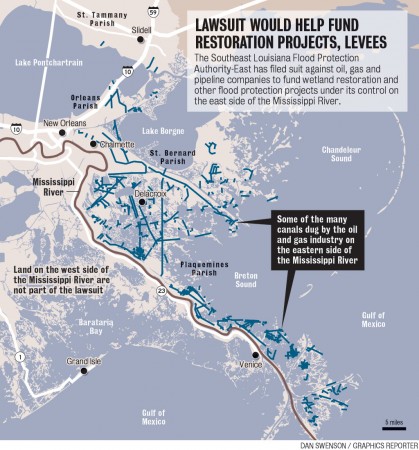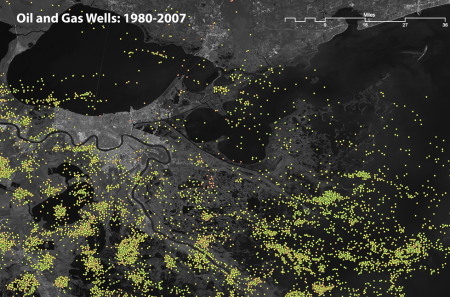Historic case is compared to 1990s litigation against Big Tobacco
About 100 oil and gas companies must pay to repair the Louisiana wetlands damaged by a century of oil exploration and extraction, according to a lawsuit filed July 24 in civil district court in Orleans Parish by the Southeast Louisiana Flood Protection Authority–East. The Authority (SLFPA-E) was established by the Louisiana legislature in 2006 after Hurricane Katrina to ensure the integrity of the state’s flood risk management systems.
John M. Barry, vice president of SLFPA-E (and the widely respected author of the award-winning Rising Tide: The Great Mississippi Flood of 1927 and How It Changed America [1998]), said:
“With this lawsuit, the Authority is carrying out its mandate to help protect southern Louisiana by strengthening our first line of defense against catastrophic flooding. That first defensive perimeter is of course the buffer of land and marsh that cuts down hurricane storm surge before it reaches the levees. . . . The industry recognizes that it is responsible for a significant part of the problem. We want energy companies to fix the part of the problem they caused—and which they promised to address. We want them to do what they said they’d do.”

The suit has been denounced by Louisiana Governor Bobby Jindal, who said in a statement that the Authority has “overstepped its authority.” The governor asserted, “We’re not going to allow a single levee board that has been hijacked by a group of trial lawyers to determine flood protection, coastal restoration and economic repercussions for the entire state of Louisiana.”
The state’s attorney general, Buddy Caldwell, however, has authorized SLFPA-E to proceed in filing its suit.
An attorney for the Authority, Gladstone N. Jones III, has successfully brought suit against Big Oil firms in the past. He told Clancy Dubos of Gambit that the suit has the potential to be bigger than the ongoing BP litigation, and, according to The New York Times, Jones said the plaintiffs are seeking damages equal to “many billions of dollars. Many, many billions of dollars.” Dubos writes, “The case ultimately could seek environmental recovery for all oil and gas activity along Louisiana’s coast. If that happens, this case will be to Big Oil what the Tobacco Litigation was to that industry: a game-changer.” (See Further Reading below.)
The lawsuit asserts that the Authority is obligated by law to restore Louisiana’s coastal land areas, and charges that oil, gas, and pipeline companies that have cut at least 10,000 miles of oil and gas canals and pipelines have damaged the state’s environmental buffer zones that formerly protected the state from storm surge and flooding. As experienced in recent hurricanes, Southeastern Louisiana has been rendered vulnerable to frequent and often catastrophic flooding.
Every year Louisiana loses 25 square miles of land—50 acres every day.
Click the map or here to go to a Lens article about the lawsuit and a slide show of the proliferation of 230,000 oil and gas wells in Louisiana between 1901 and 2007.
*
Wetlands protect human settlements from hurricane storm surges, which can rise as high as 25 feet. Every 2.5 to 4 miles of wetlands reduce hurricane storm surges by about a foot; measured another way, each mile of marsh reduces storm surges by 3 to 9 inches. Metro New Orleans, home to about 1.5 million, is now protected by a buffer no more than about 20 miles of wetlands.
The suit summarizes the environmental significance of coastal wetlands and the consequences of oil exploration (quoting from Gambit and from SLFPA-E’s press release):
• “Coastal lands are the natural protective buffer without which the levees that protect the cities and towns of southern Louisiana are left exposed to unabated destructive forces. This protective buffer took 6,000 years to form. Yet . . . it has been brought to the brink of destruction over the course of a single human lifetime. Hundreds of thousands of acres of the coastal lands that once offered protection to south Louisiana are now gone as a result of oil and gas industry activities. . . .
• “For nearly a century, the oil and gas industry has continuously and relentlessly traversed, dredged, drilled and extracted in coastal Louisiana. It reaps enormous financial gain by exploiting the resources found there, sharing some of that bounty with the many residents whom it employs. Yet it also ravages Louisiana’s coastal landscape. An extensive network of oil and gas access and pipeline canals slashes the coastline at every angle, functioning as a mercilessly efficient, continuously expanding system of ecological destruction. This canal network injects corrosive saltwater into interior coastal lands, killing vegetation and carrying away mountains of soil. What remains of these coastal lands is so seriously diseased that if nothing is done, it will slip into the Gulf of Mexico by the end of this century, if not sooner. . . .
• “Oil and gas activities continue to transform what was once a stable ecosystem of naturally occurring bayous, small canals, and ditches into an extensive—and expanding—network of large and deep canals that continues to widen due to Defendants’ ongoing failure to maintain this network or restore the ecosystem to its natural state. That canal network continues to introduce increasingly larger volumes of damaging saltwater, at increasingly greater velocity, ever deeper into Louisiana’s coastal landscape and interior wetlands. The increasing intrusion of saltwater stresses the vegetation that holds wetlands together, weakening—and ultimately killing—that vegetation. Thus weakened, the remaining soil is washed away even by minor storms. The canal network thus comprises a highly effective system of coastal landscape degradation. The product of this network is an ecosystem so seriously diseased that its complete demise is inevitable if no action is taken.” [LNW’s emphasis]
Mark Schleifstein of the Times-Picayune reports, “A study conducted by the late University of New Orleans geologist Shea Penland in 1996 for the U.S. Geological Survey and the Gas Research Institute concluded that about 36 percent of the wetland loss in southeastern Louisiana between 1932 and 1990 was the result of the direct and indirect effects of actions taken by the oil and gas industry.” By a conservative estimate, since 1932 Louisiana has lost more than 1,900 square miles of coastal lands, equivalent to the state of Delaware, and if the present rate continues, some 700 more square miles of coastal Louisiana are expected to be lost in coming decades.
John Barry told The Lens’s environmental writer Bob Marshall, “No one denies—not even the oil industry—that the canals they dredged helped cause this problem. . . . Now, people will say there are other causes, and we’re not denying that. The levees on the river, obviously, are a major cause. But the federal government built those levees, and they’ve been spending billions of dollars on better flood protection and coastal restoration projects in this area. What we’re saying to the oil companies is, ‘It’s time for you to step up now for the damage you did.’ ”
The Flood Protection Authority’s lawsuit is grounded in long-established legal principles and in state and federal law, such as the Rivers and Harbors Act of 1899, the federal Clean Water Act of 1972, and the state Coastal Zone Management Act of 1972.
Barry explained to the Times-Picayune that the suit is founded upon three principal legal arguments:
- Most of the damaging oil, gas and pipeline activities were conducted under federal and state permits that “explicitly require the operators to maintain and restore the canals they dredged,” Barry said. He said the oil and gas industry dredged more than 10,000 miles of canals through the state’s wetlands, which provided pathways for salt water from the Gulf of Mexico to kill fresh and brackish water marshes.
- The federal Rivers and Harbors Act of 1899 prohibits actions that impair the effectiveness of flood protection levees. “Clearly, increasing storm surge makes a levee less effective,” Barry said.
- A tenet of civil law called “servitude of drainage” prohibits someone taking actions on property that they own or control that sends more water onto someone else’s property. Again, Barry said, the oil and gas projects clearly focus increased storm surge onto the levee system.
The Southeast Louisiana Flood Protection Authority–East is being represented in its litigation by the law firms Jones, Swanson, Huddell, and Garrison, LLC, of New Orleans; Fishman Haygood Phelps Walmsley Willis & Swanson, LLP, of New Orleans; and Veron, Bice, Palermo & Wilson, LLC, of Lake Charles, La.
*
Further Reading
Southeast Louisiana Flood Protection Authority–East press release
Mark Schleifstein (Times-Picayune), “Historic lawsuit seeks billions in damages from oil, gas, pipeline industries for wetlands losses” (includes PDF of lawsuit + video of John Barry)
Clancy Dubos (Gambit), “Historic lawsuit coming against Big Oil”
Bob Marshall (The Lens), “Science to be key factor in lawsuit against oil and gas companies for coastal loss”
Mark Schleifstein (Times-Picayune), “East Bank levee authority to file lawsuit Wednesday aimed at getting oil, gas, pipeline firms to restore wetlands and ridges”
John Schwartz (New York Times), “Louisiana Agency Sues Dozens of Energy Companies for Damage to Wetlands”
National Public Radio, “La. Flood Board Sues Oil Industry Over Wetlands”
U.S. Geological Survey, “Wetland Subsidence, Fault Reactivation, and Hydrocarbon Production in the U.S. Gulf Coast Region”
Louisiana Coastal Protection and Restoration Authority, “Louisiana’s Comprehensive Master Plan for a Sustainable Coast”
Louisiana Coastal Protection and Restoration Authority homepage
*
Top photo of oil/gas pipeline canals cutting through Louisiana wetlands, 2010, from Getty Images via Bloomberg; graphic by Dan Swenson for the Times-Picayune; map of oil and gas wells south of New Orleans from The Lens; photograph of Barataria Bay, Louisiana (2011) by Mario Tama/Getty Images.
*



